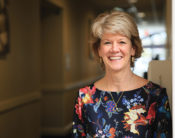You started working as a recruiter for larger companies. What was your takeaway from that experience as you and Lucas decided to start your own company?
I was recruited by a recruiting firm out of college. I didn’t know anything about recruiting, so they walked me through it. For three years I worked with two different firms, and I saw that we weren’t connecting with clients enough to understand their business. We were just doing what we had to do to get through the day: Here’s a piece of paper, here’s the job, go find someone. It felt like we were throwing people at the wall and hoping one of them would grab on.
I saw we needed to dig deeper into what the client was experiencing. What are their challenges? What are their opportunities? What’s going to happen when this person comes on board? And so with that, we created a new business plan, a new opportunity to connect with clients in new ways.
We recognized how important it was as a business to get into the community, to see it, to feel it, and to talk to people, even outside of the manufacturing facility. You have no idea what it’s like until you’re there, physically. We started with Polaris in Roseau, Minnesota. We met with the company, we met realtors, a school principal…we really got into it. It was huge. With that perspective, you can speak to talent on an entirely different level. You get a sense of what kind of person is really going to be attracted to this location. I mean, in the winter they can drive their snowmobiles to work. As an advisor and as somebody in our business, you have to know all of the challenges.
What is your sweet spot placement?
We’re working on placing experienced individual contributors to senior and executive leadership. We work with a wide range of growth-oriented, private, family-owned companies to public companies, typically $20 million to $400 million in revenue. They want one partner who they can trust and go to and say, “I need a strong director of quality. I need a strong national account manager. I need a strong project engineer. I need a strong VP of operations.” We are a generalist firm that focuses on long-term partnerships.
So, what’s your advice to the $5 million company? What can they learn from your experience?
You need to focus on your brand. There was a day where you could say that prospective employees didn’t go to your website. Today, that’s the first thing they do when they research your company. If your website doesn’t convey a compelling brand identification, it will be more challenging to attract people to work at your company, let alone customers. You have to tell your story. You have to identify who you are, what you do in the marketplace, and why someone might want to come and work with you.
A high percentage of companies we work with are missing the boat on describing, “Who are we? What’s our secret sauce?” This was an aha moment for us. As a starting point for a small business, I recommend investing in your company and employer brand first to define their identity. If you can capture that, you might not need an outside support system to go out and attract talent.
Over the years, we’ve been going into our client communities and spreading awareness of their business and needs. Nine times out of ten, people in the community say, “I didn’t even know these types of opportunities existed.” And so, here we are being a brand advocate as much as a recruiter in their community. We saw this as an opportunity, and we rebranded our own company and acquired a small boutique branding and design firm. It was an amazing connection that changed our entire world—from how we connect with our clients and prospective candidates, to the way we communicate who we are and what we do differently, to the way potential clients are approaching us.
We referred a branding and design firm to help our clients go through their identity process. It became obvious to Lucas and me that offering both strategic search and branding design services made sense, so we acquired Davies Branding + Design. Who are you, what do you do, why do people want to come work for you? What gets the current employees excited to be there? That’s their employment brand. It’s exciting and fun work to do for clients who work with us, because as soon as they start seeing the impact it makes, a light bulb goes off and they’re even more excited to talk about their brand.
A sales differentiator?
How can you attract the right talent if you don’t know your true brand? Brand is your company’s unique identity; it is the way you’re communicating to the marketplace and ties everything together. If companies could capture what their brand is and means, and then spend time investing into it, they would close some of their employment gaps. To take it a step further, it’s the way you communicate with your employees, the way you write your job descriptions, the hard vs. soft skills required for the roles, and even the internal interview process you put all candidates through for your open positions. It is easy to get caught in the “this is the way we’ve always done it” mentality, but once you start to step outside the box and even become a bit “disruptive,” you will see your employment gaps become smaller and your job openings close with the right talent!
There are many opportunities for companies to think and act differently to separate themselves as the best place to work and grow; that’s where we have found our key differentiator with Grey Search + Strategy, thinking differently and acting upon it.
…
Featured story in the Summer 2019 issue of Enterprise Minnesota magazine.


